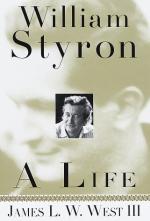|
This section contains 1,809 words (approx. 7 pages at 300 words per page) |

|
SOURCE: "The Idea Men," in Man's Changing Mask: Modes and Methods of Characterization in Fiction, University of Minnesota Press, 1966, pp. 251-57.
In the following assessment of The Long March, Walcutt argues that the author had to sacrifice characterization and credibility to get his point across.
In his novelette The Long March . . . William Styron has gathered all his forces to dramatize an idea about Jewish character. It is as unsympathetic as it is suggestive. It generates a great deal of imaginative power; and it seems to be going deep into the roots of character until its symbolic purpose takes open charge and reduces the action to an expository contrivance. . . . The characters of significance are just three: the dedicated professional soldier, Colonel Templeton, aged forty-four; Lieutenant Culver, about thirty, who has been snatched from a happy marriage and a promising career to a nightmare of forced training; and Captain Mannix...
|
This section contains 1,809 words (approx. 7 pages at 300 words per page) |

|


